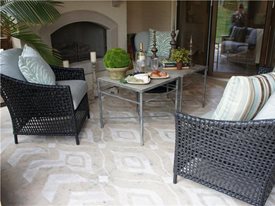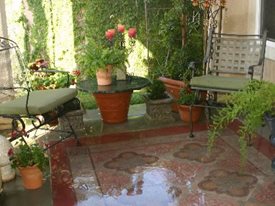
Bella Tucker Decorative Finishes in Franklin, TN
Concrete stencils are an effective way to give a plain concrete patio or porch some instant wow-factor. You only need a few basic tools and materials to create any pattern you want. Choices range from simple tile designs to elaborate faux concrete "area rugs". Even better, little artistic skill is required to create these eye-catching designs.
Stenciling a patio isn’t much more complicated than stenciling a wall or piece of furniture. But there are some general rules of thumb that should be followed to achieve a long-lasting, attractive surface. Here’s what you need to know to get started.
Pros & cons of stenciling concrete patios
Pros:
- Today’s adhesive-backed stencils make it easy to keep a pattern in place while applying a finish or a topical color.
- If you want to make a project unique, stencils can be customized to fit your design needs.
- Can be very economical, especially if you do the work yourself.
- Stenciled patterns will often hide minor cracks in concrete, making repair unnecessary.
Cons:
- Custom stencils will cost considerably more than a stock pattern, and they typically aren’t reusable.
- Elaborate stenciled patterns can be tricky to lay out, and mistakes are difficult to correct later.
- May require occasional touch-ups, especially in high-traffic areas.
- For good results, you need to know how to apply the stencils and what coloring mediums and techniques to use.
Want a pro to do the stenciling for you?
Find concrete contractors near me
What type of stencils can I use on concrete?
No matter what your design goal, there’s probably a stencil product on the market that can help you achieve it. However, not all stencils will suit all purposes, depending on their composition, thickness, size, and durability.
Adhesive-backed stencils are easiest because they have a self-stick backing and don't need to be taped to the surface. They'll stay nicely in place while you apply a finish or color, such as concrete paint or stain. As an alternative, you can use nonadhesive stencils made of plastic and hold them in place using a repositionable spray adhesive.
Tip: If you don’t want to purchase stencils, it’s also possible to create simple designs using painter’s tape. Try stripes, checkerboards, and diamond patterns. However, you’ll need to measure and plot out the pattern carefully to get good results.
How do I prep a concrete patio for stenciling?
For good adherence, apply stencils to surfaces free of grease, oil, dirt, and dust (see guidelines for concrete patio cleaning). If you're using concrete porch and patio paint to create your stenciled design, the concrete should be given a slight texture. This can be achieved through acid etching or mechanical abrasion to ensure proper paint adhesion. A coat of bonding primer may also be required, depending on the product you’re using.
You might not need to worry about repairing minor cracks in your concrete patio, because the stenciled pattern will disguise them. However, large cracks, gouges, or holes in the concrete should be patched first with an exterior concrete crack filler. Learn more about repairing cracks in concrete patios.
